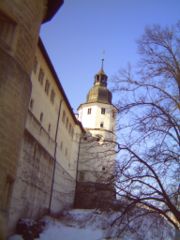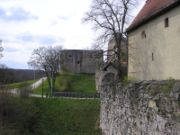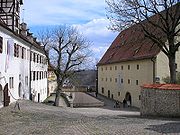
Schloss Hellenstein
Encyclopedia

Baden-Württemberg
Baden-Württemberg is one of the 16 states of Germany. Baden-Württemberg is in the southwestern part of the country to the east of the Upper Rhine, and is the third largest in both area and population of Germany's sixteen states, with an area of and 10.7 million inhabitants...
, Germany
Germany
Germany , officially the Federal Republic of Germany , is a federal parliamentary republic in Europe. The country consists of 16 states while the capital and largest city is Berlin. Germany covers an area of 357,021 km2 and has a largely temperate seasonal climate...
. It was once the home of the Lords of Hellenstein.
The castle
Castle
A castle is a type of fortified structure built in Europe and the Middle East during the Middle Ages by European nobility. Scholars debate the scope of the word castle, but usually consider it to be the private fortified residence of a lord or noble...
was first built during the 12th century by the Hellenstein family. In 1273 the castle passed out of the control of the Hellensteins and had several owners before coming under the control of the Dukes of Württemberg. On August 5, 1530 the old castle burned to the ground and was rebuilt during the mid-16th century. At the end of the century it was expanded on its eastern flank to create a new castle. During the seventeenth and early 18th century the castle was at its peak as a symbol of the Württemberg dukes. Around 1762 the family could no longer maintain the castle and it began to fall into disrepair. Eventually some of the stones were sold off as building material.
In 1901 the former castle church was acquired by the Folk and Ancient History Society of Heidenheim as a museum. The museum expanded throughout the first half of the 20th century, until in 1956 the entire castle was rebuilt as a museum. In 1993 the city of Heidenheim took over the museum from the Society. Today the castle contains several museums which are open from March 15 until November 15 Tuesday through Sunday.
History

Rustication (architecture)
thumb|upright|Two different styles of rustication in the [[Palazzo Medici-Riccardi]] in [[Florence]].In classical architecture rustication is an architectural feature that contrasts in texture with the smoothly finished, squared block masonry surfaces called ashlar...
(squared stone blocks with a rounded or rough outer surface) that date from this time period. The castle remained in the hands of the Hellensteins until 1273 when the male line died out. For almost eighty years the castle passed through several owners. In 1351 the count
Count
A count or countess is an aristocratic nobleman in European countries. The word count came into English from the French comte, itself from Latin comes—in its accusative comitem—meaning "companion", and later "companion of the emperor, delegate of the emperor". The adjective form of the word is...
s of Helfenstein
House of Helfenstein
The House of Helfenstein was a German noble family during the High and Late Middle Ages. The family was named after the family castle, Castle Helfenstein, located above Geislingen an der Steige in the Swabian Alb region of Baden-Württemberg, Germany...
acquired the castle and ruled it for nearly a century, until 1448. Finally in 1503 the castle came under the control of the duke
Duke
A duke or duchess is a member of the nobility, historically of highest rank below the monarch, and historically controlling a duchy...
s of Württemberg
Rulers of Württemberg
This is a list of the rulers of the German state of Württemberg, originally a county and eventually a kingdom until the ruling dynasty was overthrown in 1918.- Counts of Württemberg to 1495 :* Konrad I 1089–1122...
.
On August 5, 1530 the castle burned to the ground. Ulrich I. von Württemberg ordered that the castle be rebuilt a few years later; the reconstruction lasted from 1537 to 1544. When Duke Frederick I
Frederick I, Duke of Württemberg
Friedrich I of Württemberg was the son of Georg of Mömpelgard and his wife Barbara of Hesse, daughter of Philip I, Landgrave of Hesse....
assumed the ducal throne in 1593, he decided that a new castle should be built as an extension east of the old medieval castle. The new castle should be modern and represent the power of the Württemberg dynasty. A planning commission was set up which selected the master builder Henry Schickhardt in 1595. The walls were extended and new towers were built. Two large, decorated towers were built next to the new main gate. A new modern water system, that lifted the water 90 metres (295.3 ft) to the castle. The construction lasted until 1611.

Thirty Years' War
The Thirty Years' War was fought primarily in what is now Germany, and at various points involved most countries in Europe. It was one of the most destructive conflicts in European history....
(1618–1648) the castle was damaged and the complex water supply system was destroyed. Before the castle could be reoccupied, a new water supply had to be found. From 1666 to 1670 the Kindlesbrunnen a 78 metres (255.9 ft) well was dug in the southern part of the castle. The name, Kindlesbrunnen ("baby fountain"), comes from a local legend that instead of being brought by the stork, babies are pulled from the well before they are born. The well cost about 6,750 guilders or about €500,000 in modern currency.

War of the Spanish Succession
The War of the Spanish Succession was fought among several European powers, including a divided Spain, over the possible unification of the Kingdoms of Spain and France under one Bourbon monarch. As France and Spain were among the most powerful states of Europe, such a unification would have...
, a French officer with 10,000 men again attempted to take the castle. When they arrived in Heidenheim, they evaluated the castle and the cost of attacking. The commander finally determined that Hellenstein would be too costly to attack, and retreated without firing a shot.
During the seventeenth and early 18th century the castle was at its peak. Artists and sculptors were brought in to decorate and beautify the castle. In 1593 Frederick I commissioned the Bavaria
Bavaria
Bavaria, formally the Free State of Bavaria is a state of Germany, located in the southeast of Germany. With an area of , it is the largest state by area, forming almost 20% of the total land area of Germany...
n court painter Friedrich Sustris
Friedrich Sustris
Friedrich Sustris was a German-Dutch painter, decorator and architect. He was a son of the artist Lambert Sustris, who worked in Italy....
to paint the walls and ceiling of the round tower. The castle also hosted many prominent guests including Albrecht von Wallenstein
Albrecht von Wallenstein
Albrecht Wenzel Eusebius von Wallenstein , actually von Waldstein, was a Bohemian soldier and politician, who offered his services, and an army of 30,000 to 100,000 men during the Danish period of the Thirty Years' War , to the Holy Roman Emperor Ferdinand II...
(in 1630), Prince Eugene of Savoy
Prince Eugene of Savoy
Prince Eugene of Savoy , was one of the most successful military commanders in modern European history, rising to the highest offices of state at the Imperial court in Vienna. Born in Paris to aristocratic Italian parents, Eugene grew up around the French court of King Louis XIV...
(in 1702), Archduke Charles of Austria
Archduke Charles, Duke of Teschen
Archduke Charles of Austria, Duke of Teschen was an Austrian field-marshal, the third son of emperor Leopold II and his wife Infanta Maria Luisa of Spain...
, (in 1796) and Napoleon Bonaparte
Napoleon I of France
Napoleon Bonaparte was a French military and political leader during the latter stages of the French Revolution.As Napoleon I, he was Emperor of the French from 1804 to 1815...
(in 1805).
By the mid-18th century the castle had lost importance. Around 1762 the duchy could no longer support renovations on Hellenstein. In 1810 the upper floor of the tower battery was removed and sold as building material. Unfortunately, the wall and ceiling paintings by Friedrich Sustris were destroyed when the upper floor was removed. In 1820 the Ministry of Finance authorized the sale and demolition of the entire old castle. A year later the paper factory Völter, removed portions of the castle to provide building material for their factory. In 1837 the royal planning commission forbade anyone else to remove stones from Hellenstein.
From castle to museum

There are actually two different museums in the castle, which can be visited on separate tickets or on a combination ticket. The Museum für Kutschen Chaisen Karren or transportation museum located in the old Fruchtkasten. This museum documents the growth and development of means of transportation before the automobile. In 1987 it was honored by the Europäischen Museums Forum for excellent design and execution. The castle museum includes a theatre which shows movies about the history of Heidenheim, local ancient artifacts, religious art, antique toys and Alfred Meebold's Indian Collection.
Broadcasting station of SWR
SWR operates on Hellenstein castle a low power broadcasting facility, which transmits the following programmes| Program | Frequency | ERP Effective radiated power In radio telecommunications, effective radiated power or equivalent radiated power is a standardized theoretical measurement of radio frequency energy using the SI unit watts, and is determined by subtracting system losses and adding system gains... [kW] |
|---|---|---|
| SWR1 Baden-Württemberg | 87,6 MHz | 0,1 kW |
| SWR4 Baden-Württemberg - Schwabenradio | 89,8 MHz | 0,1 kW |
| SWR3 | 97,6 MHz | 0,1 kW |
| SWR3 | 97,6 MHz | 0,1 kW |
| SWR2 - Reg. Baden-Württemberg | 99,1 MHz | 0,1 kW |
Until November 1993, there was also a mediumwave broadcasting station on Hellenstein Castle working on 1413 kHz with 100 W.

